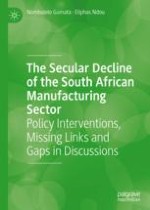2020 | OriginalPaper | Buchkapitel
3. Does Trade-Openness Affect the Role of the Domestic Output-Gap on Inflation? If So, What is the Role of the Global Output-Gap?
verfasst von : Nombulelo Gumata, Eliphas Ndou
Erschienen in: The Secular Decline of the South African Manufacturing Sector
Aktivieren Sie unsere intelligente Suche, um passende Fachinhalte oder Patente zu finden.
Wählen Sie Textabschnitte aus um mit Künstlicher Intelligenz passenden Patente zu finden. powered by
Markieren Sie Textabschnitte, um KI-gestützt weitere passende Inhalte zu finden. powered by
